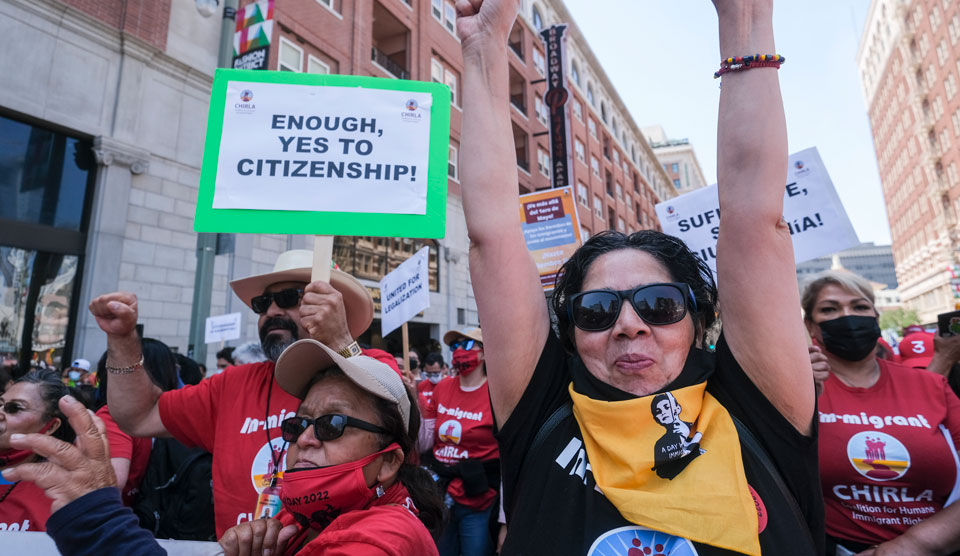
Miami Republican Representative Maria Elvira Salazar (Fla.-27), along with a contingency of Republican House colleagues, introduced an immigration reform bill on Feb. 8, 2022, that she coined the “Dignity Act.” It consists of three underlying core principles:
- 1) Stopping Undocumented Immigration;
- 2) Provide a Dignified Solution for Undocumented Immigrants Living in the United States; and
- 3) Strengthen the U.S. Workforce and Economy.
Let’s examine and interrogate some of the malicious ideologies built into the bill. We don’t take away from the expressed ideals and some of the positive outcomes for undocumented immigrants in the proposed Act, nor deny that such a piece of legislation may be the right direction that we should take. However, through a historical lens, we have to grapple with its premises that normalize the elimination of the perpetual foreigner. Of concern is the ramped-up criminalization rhetoric, the posited solution being the militarization of the Mexico-U.S. border. When such ideologies are furthered we must ask for the benefit of whom and tragically at what human cost?
In scrutinizing the Dignity Act, we find multiple echoes of the “perpetual foreigner” threat in U.S. society, in this scenario connected to the southern U.S. border. The perpetual foreigner stereotype has been historically used by bigots and pundits to espouse racist xenophobic nativism aimed at ethnic minorities, both naturalized and native-born, whose families have been U.S. citizens for generations, thus exiling them from national belonging as unassimilable or a threat to white national unity. Such a sense of national security threat never seems to die out and is reproduced intergenerationally as an evergreen political scapegoat. Clif Stratton talks about this in the 2016 study Education for Empire: American Schools, Race, and the Paths of Good Citizenship.
For example, Title I: Border Security for America Act asserts a need for border barriers including but not limited to air support reconnaissance, deployment of different surveillance technologies to different sectors of the border, and a heightened hug-the-border approach by border patrol agents to ensure the safety of U.S. citizens. These are just a few examples of the ramped-up militarization of the security state rhetoric in furthering the Dignity Act. The Sonoran Desert in Arizona speaks to the countless lives, both accounted and unaccounted for, sacrificed in silence owing to the consequences of such quasi-military experiments in controlling economic refugees as they are strategically flanked into kill zones of exposure to the natural elements of the harsh desert terrain.
When such demand for heightened border security is implemented within otherwise purportedly humanitarian legislation, we must ask where such funding is allocated, and how it contributes to intensifying the Border Industrial Complex (BIC). Expansion of the BIC presupposes the criminalization of border crossers, which forces immigrants and asylum seekers into uninhabitable terrain where they face assault, extortion, and in many instances dehydration, starvation, and death.
Thus, at the expense of the criminalized perpetual foreigner, the true beneficiaries who benefit from “humane” comprehensive immigration “reform” are the corporations that profit from the militarization of the border. For example, between 2009 and 2020 the federal government issued $55 billion in contracts to the BIC. Many billions of those dollars have been used to fund predator drones and intrusive biometric security systems.
Moreover, in the last 13 years Immigration enforcement budgets have more than doubled, and since 1980 have increased staggeringly by more than 600%, as Robert Reich has documented.
The second point of contention is the criminalization of youth through Title X: Gang Member Removal, which allows the Department of Homeland Security Secretary to identify and name “criminal street gangs” of five members or more, whose members would be deportable and inadmissible to the U.S. Such designation has serious consequences in how youth of color are viewed in schools and treated by law enforcement.
As seen in the contemporary struggle by Black Lives Matter, law enforcement is not immune from deeply embedded racism, exhibited by out-of-control police misconduct. Neither are nativist ideologies absent among educators who further a school-to-prison pipeline through the mistreatment and punitive discipline of ethnic minority students, in particular undocumented students who are viewed with disdain due to their legal status, language, culture, and identity. (Christopher A. Mallett’s 2015 book The School-to-Prison Pipeline: A Comprehensive Assessment is a good source on this.) We must also recall the gang injunctions of the 1980s and 1990s that particularly targeted Latino and African American youth, and the long-term influence and repercussions that CRASH and RAMPART had in the Los Angeles Police Department across the nation.
By allowing a clear playing field for such ideologies to flourish through “humane” immigration reform, we not only allow the criminalization of the foreign-born, but also the native-born who are often criminalized through gang injunctions, rendering them disqualified voices in society through such stigma. Thus, we normalize the “othering” of perpetual foreigners as they are persecuted as human targets by state apparatuses which feed the U.S. criminal justice system and the Prison Industrial Complex. (An important contribution on this is Victor M. Rios, Human Targets: Schools, Police, and the Criminalization of Latino Youth [2017]).
We must attack the root causes of our national social ills, which include how schools socialize youth to deny them an expression of collective identity with an arbitrary approach, attempting to transform them by storied “rugged individualism” through hateful legacies of discrimination such as Americanization and Anglo conformity.
José-Antonio Orosco tackled this theme in a 2016 book, Toppling the Melting Pot: Immigration and Multiculturalism in American Pragmatism. This all adds up to a tightly wrapped package stuffed with racism and prejudice through conformist social stratification, and a continued war waged against the poor and the socially undesirable in a predatory capitalist society.
These underlying premises are of legitimate concern as they are based on exclusionary and malicious rhetoric. But we must also examine the positive outcome in the furthering of the proposed legislation. For example, Rep. Salazar claims the bill will halt undocumented immigration to the United States and provide a dignified “solution” to the legal status of millions of undocumented immigrants. Under the Dignity Act, DREAMERS and DACA recipients would receive a 10-year temporary permanent resident status. Temporary Protected Status (TPS) and Deferred Enforced Departure (DED) holders would be eligible for lawful permanent resident status after five years of continuous presence in the U.S. Anyone who didn’t fall into one of these categories would be required to apply for a 10-year program of work authorization, pay $10,000 restitution over 10 years, and give up 2% of their paycheck to the Immigration Infrastructure Fund.
However, no one in this program would receive a green card unless Border Patrol and a Border Security Certification Task Force certify that BP is apprehending at least 90% of individuals attempting to cross the border unlawfully. So while this legislation in some ways sounds (to Republicans) like a positive step toward immigration reform, it is quite punitive and focuses greatly on enhanced border security and a mandatory e-verify program. And any immigrant applying for the “Dignity Program” would be required to admit to a felony (that of being undocumented—an added provision in this bill) and thus be subject to arrest at any moment. The bill includes several other negative provisions: detaining families seeking asylum in processing centers on the border for up to 150 days; making “fraudulent representation concerning asylum” a federal crime punishable for up to 10 years; authorizing indefinite and mandatory detention for immigrants before they have been ordered removed; and making it a felony crime to “aid and abet” undocumented people remaining in the U.S.
Crafted in consultation with U.S. leaders in agriculture and farming, business, faith-based organizations, and border security experts, the Dignity Act will be deemed a step forward by some, perhaps realistically the only approach that could possibly thread the needle of a sharply divided Congress. According to this piece of legislation, the solution to comprehensive immigration would be the securing of the Mexico-U.S. border and reestablishing “law and order” in our immigration system. The outcome for a path to citizenship would be a 10-year Dignity Program that would provide renewable legal status and offer an additional redemption path to permanent legal status in the United States. According to its architects, this reasonable and compassionate approach will be the solution to fixing a decades-long broken immigration system.
However, we reiterate: At what cost and for whom?











